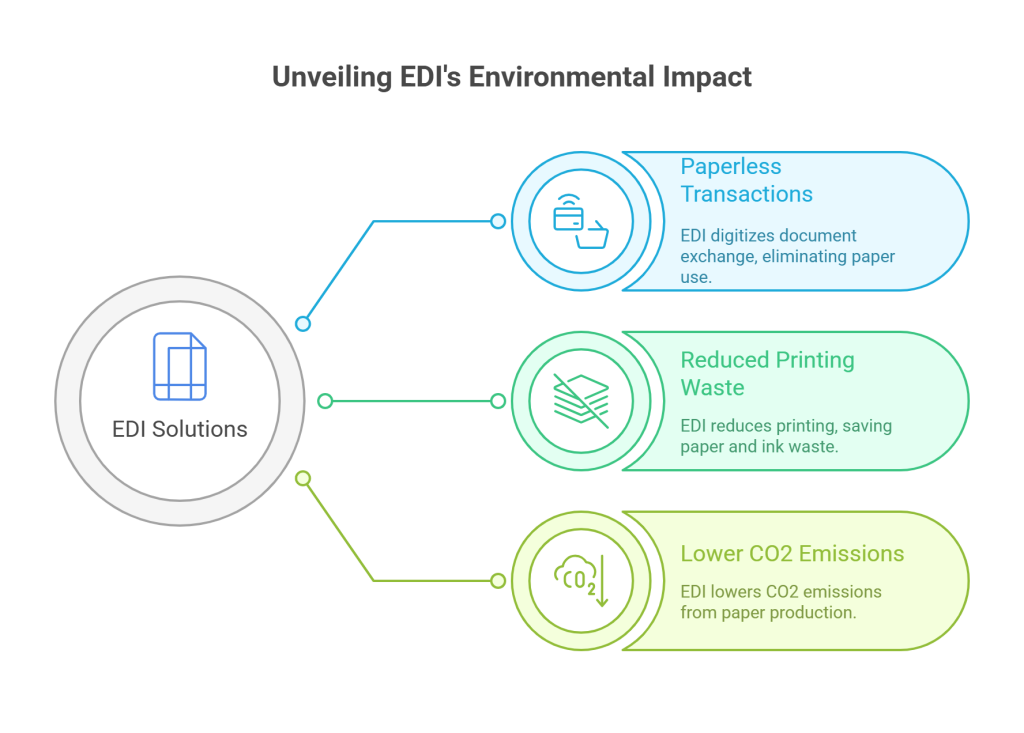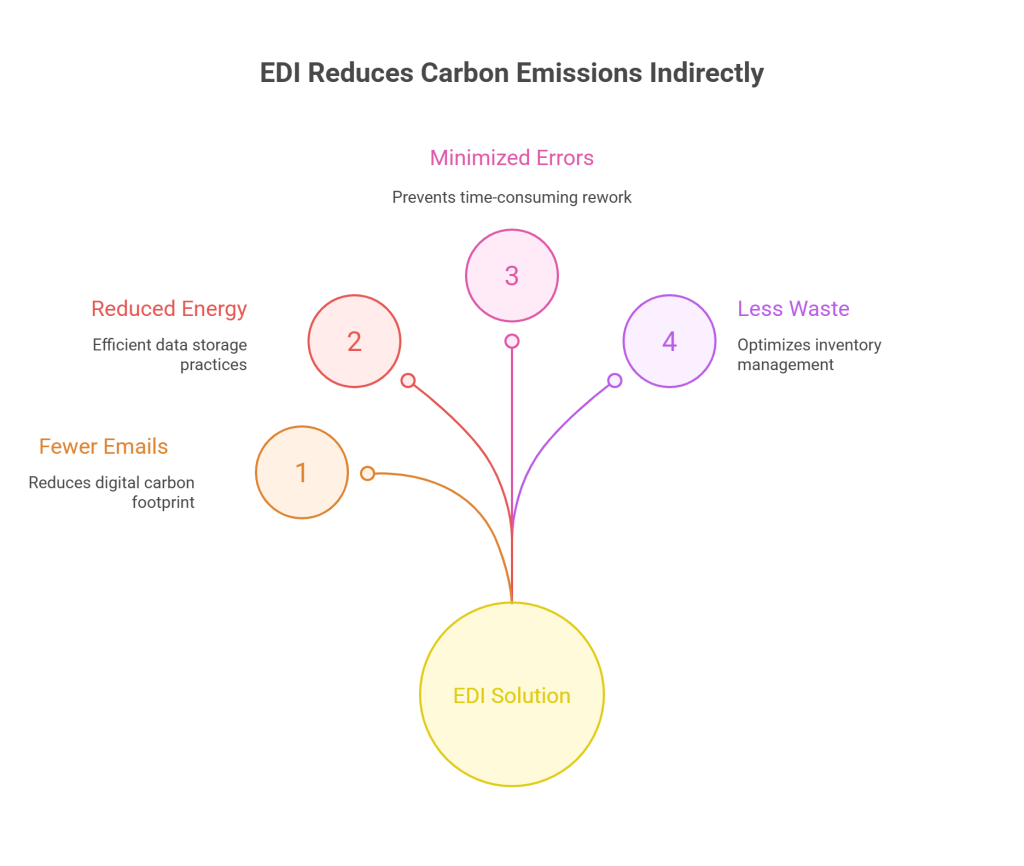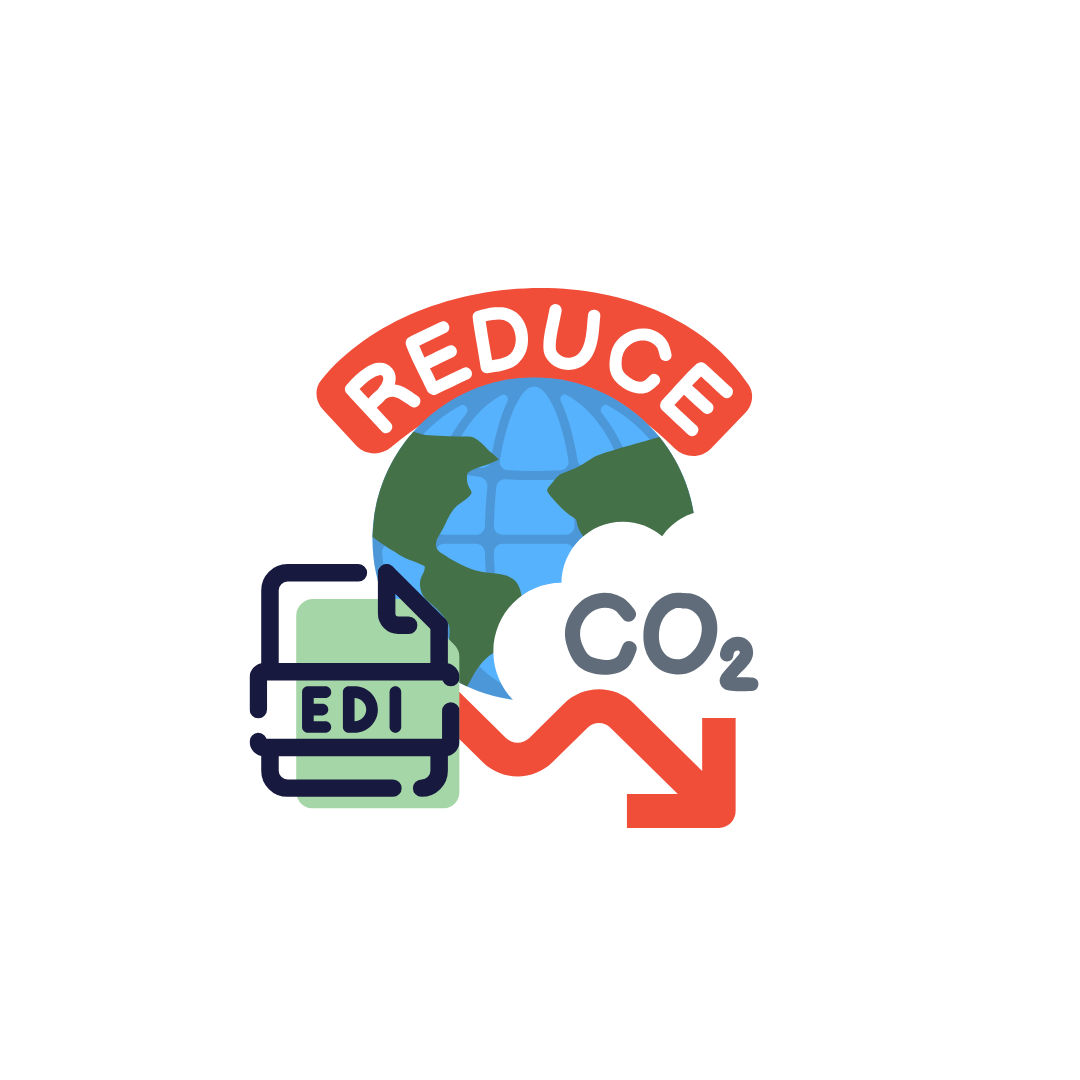Introduction
Carbon footprint reduction starts with addressing the most wasteful business practices.
Did you know that a typical mid-sized business produces around 18,000 invoices annually, equivalent to two tons of paper waste?
Furthermore, considering the average employee prints 500 A4 sheets per year, a company of just 10 people consumes approximately 5000 pieces of paper annually. This level of paper consumption has significant environmental consequences. Each year, this paperwork costs about five trees and generates substantial CO2 emissions, as one kilogram of paper produces roughly one kilogram of CO2 during its production lifecycle.
However, there’s a proven solution that’s already making an impact—Electronic Data Interchange (EDI). EDI usage in the supply chain sector is estimated between 59% and 85%, with nearly 70% of all B2B transactions in North America’s retail, healthcare, and manufacturing industry in 2024 conducted through EDI systems.
At Commport Communications, we’re committed to providing effective carbon footprint reduction strategies through our comprehensive suite of EDI solutions. Our approach eliminates paper-based documentation like purchase orders, invoices, and shipping notices, directly contributing to your carbon footprint reduction plan.
Throughout this blog, we’ll explore the direct and indirect environmental benefits of EDI, practical carbon footprint reduction methods, and how our EDI-capable systems are helping forward-thinking companies achieve their sustainability goals.
Key Takeaways
- EDI technology offers business leaders a powerful dual solution: significant environmental impact reduction alongside improved operational efficiency. Here’s what you need to know about EDI’s proven carbon footprint benefits:
- Paper elimination delivers massive environmental savings – A mid-sized business produces 18,000 invoices annually (2 tons of paper), but EDI completely digitizes these transactions, saving trees and CO2 emissions.
- Indirect carbon reductions multiply the impact – EDI reduces email volume, minimizes digital storage waste, prevents error-related rework, and decreases machine usage beyond just paper savings.
- Strategic sustainability gains optimize entire supply chains – Real-time inventory data prevents overproduction, enables vendor-managed inventory, optimizes shipping routes, and improves recall management efficiency.
- Environmental responsibility aligns with business efficiency – Companies achieve cost savings through reduced printing, postage, and administrative expenses while meeting sustainability goals and regulatory requirements.
How Commport EDI Solutions Help Businesses Go Paperless
Commport Communications stands at the forefront of enabling businesses to eliminate paper-based processes through advanced EDI solutions. As organizations seek effective carbon footprint reduction strategies, our comprehensive EDI solutions offer a direct path to sustainability goals while improving operational efficiency.
1. Our Role in Digital Transformation
Commport empowers businesses with comprehensive solutions for Electronic Data Interchange (EDI), Global Data Synchronization Network (GDSN), Commport Product Information Management (PIM), and Value Added Network (VAN) services. Our integrated EDI software provides a complete suite of tools for managing and processing EDI transactions, including mapping, translation, and validation – compatible with various EDI standards from custom flat files to ANSI X12, EDIFACT, and XML.
For businesses just beginning their digital transformation journey or those with lower volume needs, our Cloud EDI offers an economical and user-friendly solution that brings automation and control to fulfillment processes. Additionally, we serve over 6000+ customers and more than 5,000 trading partners, processing over 140,000 transactions daily.
2. Reducing paper waste through EDI solutions
Our integrated EDI enables the electronic transmission of critical business documents, including:
- Purchase orders and invoices
- Shipping notices and delivery confirmations
- Inventory updates and forecasts
This electronic exchange eliminates paper-based processes, consequently reducing printing, postage, and administrative costs associated with traditional document handling. By removing the need for physical documentation, our solutions help cut down on paper consumption that typically results in deforestation and greenhouse gas emissions.
3. Supporting carbon footprint reduction plans
Commport’s EDI solutions contribute significantly to environmental sustainability by minimizing the carbon footprint associated with traditional document handling. Beyond direct paper reduction, our systems decrease energy consumption related to document processing, storage, and transportation.
Through our specialized EDI implementations, businesses experience streamlined communication with trading partners, fewer errors requiring correction (and additional resources), and optimized inventory management. These improvements not only enhance operational efficiency but primarily support broader carbon footprint reduction plans by eliminating wasteful practices throughout the supply chain.
For businesses committed to sustainability goals, Commport’s scalable solutions adapt to evolving needs while maintaining a steadfast focus on environmental responsibility, positioning our clients for continued success in an increasingly eco-conscious marketplace.
Direct Environmental Benefits of EDI
The environmental impact of traditional paper-based business processes is staggering. At Commport Communications, our EDI solutions directly target these environmental challenges by eliminating paper documentation throughout the supply chain

1. Paperless Transactions and Document Exchange
EDI completely transforms document exchange by digitizing critical business communications. This paperless approach eliminates the need for printed invoices, purchase orders, and shipping documents, replacing them with secure electronic transactions. For businesses implementing EDI sustainability solutions, this means fully digitized document exchange that removes the necessity for:
- Printed invoices and purchase orders
- Manual fax or mail transactions
- Physical storage of paper records
2. Reduced Printing and Office Supply Waste
The environmental savings from reduced printing are substantial. A typical mid-sized business produces approximately 18,000 invoices annually, equivalent to two tons of paper. Moreover, considering the average employee prints roughly 500 A4 sheets yearly, a company with just ten employees would consume around 5000 sheets of paper annually.
This reduction extends beyond paper. By adopting electronic document management, businesses also minimize ink usage and printer cartridge waste. About 375 million empty ink and toner cartridges are discarded yearly, with most ending up in landfills where they take up to 1,000 years to decompose.
3. Lower CO2 Emissions From Paper Production
The environmental impact of paper production is often overlooked. Each kilogram of paper produces approximately one kilogram of CO2 during its production lifecycle. Additionally, the papermaking process—from tree cutting to processing and shipping—generates significant greenhouse gas emissions.
By implementing Commport’s EDI solutions, businesses not only eliminate paper waste but also reduce transportation-related emissions previously required for document delivery. Our comprehensive approach enables companies to adopt eco-friendly supply chain practices, essentially cutting waste, energy consumption, and emissions while improving operational efficiency.
Make an Impact Today. Reduce Your Carbon Footprint and Improve Your Business Efficiency by Switching to Commport EDI Solutions and Automating All Your EDI Transactions.
Indirect Ways EDI Reduces Carbon Emissions
Beyond the obvious paper savings, EDI creates substantial environmental benefits through several indirect pathways. At Commport Communications, we’ve observed how our EDI solutions create ripple effects throughout business operations, contributing to carbon footprint reduction in ways many organizations initially overlook.

1. Fewer Emails and Digital Clutter
Though rarely considered in sustainability discussions, emails carry a surprising environmental impact. The carbon footprint of emails depends on:
- Storage duration (longer storage requires more server energy)
- Email size (larger emails consume more transmission energy)
- Number of recipients (multiplying the carbon footprint)
- Attachments (increasing size and generating energy)
A 2019 study revealed that people in the UK send 64 million unnecessary emails daily, and eliminating just one “Thank you” email per day would save 16,433 tons of carbon annually—equivalent to 81,152 flights from London to Madrid. By implementing Commport’s EDI solutions, companies dramatically reduce email volume since EDI efficiently handles most business partner communications.
2. Reduced Energy Use from Data Storage
Digital clutter—including unnecessary files, emails, and applications—consumes significant server energy. Remarkably, up to 90% of stored data is never accessed after three months. EDI streamlines data exchange, enabling more efficient storage practices and subsequently reducing the energy consumed by data centers that power business operations.
3. Minimized Errors and Rework
EDI substantially improves supply chain efficiency through faster, more accurate data exchange. This improved accuracy primarily prevents errors that typically trigger time-consuming rework processes. Without EDI, manual data entry errors often result in extensive runarounds, lost time, and unnecessary machinery use—all contributing to an increased carbon footprint. Our EDI solutions at Commport eliminate these inefficiencies, preventing the environmental costs of correction cycles.
4. Less Machine Usage and Operational Waste
Traditional document processing requires printers, fax machines, and copiers that consume electricity and resources throughout their lifecycle. Furthermore, EDI optimizes inventory management and forecasting, reducing instances of overproduction and waste. This enhanced efficiency helps businesses align supply with demand, correspondingly preventing excess stock that might otherwise be discarded or require rushed, inefficient shipments.
Strategic Sustainability Gains from EDI
The strategic impact of EDI on sustainability goes well beyond immediate paper reduction. At Commport Communications, we’ve seen how our EDI solutions create long-term environmental benefits through fundamental improvements in core business operations.

1. Improved Inventory Forecasting and Demand Planning
EDI provides real-time inventory and order data that transforms demand planning accuracy. This visibility allows businesses to maintain optimal stock levels, avoiding both overstocking and shortages. Poor inventory management often leads to overproduction, stockpiling, and excess waste, yet EDI helps align supply with demand, fundamentally reducing:
- Excess stock that ultimately becomes waste
- Emergency shipments due to stockouts
- Resource waste from miscommunication
By automating inventory updates and demand forecasting, our EDI solutions enable businesses to analyze sales trends and inventory turnover rates, thereby preventing wasteful resource consumption.
2. Enabling Vendor-Managed Inventory (VMI)
Vendor-managed inventory represents a notable advancement in supply chain sustainability. In this arrangement, suppliers take responsibility for managing inventory levels at the customer’s location, utilizing real-time demand data facilitated through EDI.
VMI emerged in the 1980s as part of broader efforts to streamline supply chains and has since gained popularity across retail, automotive, and manufacturing sectors. This approach optimizes inventory based on real-time data exchange, which leads to reduced carrying costs as excess inventory and stockouts are minimized.
3. Optimized Shipping and Packaging
Shipping and transportation contribute substantially to carbon emissions. Through EDI-powered advanced shipping notices (ASNs), businesses can plan shipments more efficiently. Furthermore, EDI-integrated transportation planning ensures trucks and cargo containers operate at optimal capacity, reducing partial-load shipments that waste fuel and generate unnecessary emissions.
Real-time visibility enables companies to adapt shipping routes based on actual demand, eliminating unnecessary miles. This optimization directly supports carbon footprint reduction plans through more efficient resource utilization.
4. Better Traceability and Recall Management
Traceability—the ability to track items throughout manufacturing and the supply chain—becomes remarkably more effective with EDI. In the unfortunate event of a product recall, EDI streamlines the entire process through rapid and accurate communication, providing real-time data and automating critical processes.
This enhanced traceability delivers real-time visibility into product movement and status, enabling manufacturers to optimize their supply chain, reduce lead times, and improve inventory management. For businesses committed to comprehensive carbon footprint reduction strategies, these capabilities minimize waste from recalled products and prevent the environmental impact of replacement production.
At Commport Communications, we’re dedicated to supporting businesses in their sustainability journey through EDI solutions that deliver these strategic environmental benefits while simultaneously improving operational efficiency.
Conclusion
As businesses increasingly prioritize sustainability, EDI stands out as a proven solution for meaningful carbon footprint reduction. Throughout this article, we’ve demonstrated how Commport’s EDI solutions eliminate paper waste while simultaneously addressing less obvious environmental impacts.
Paper-based processes damage our environment. Each year, companies waste thousands of trees and generate substantial CO2 emissions through traditional document handling. Therefore, our comprehensive EDI systems tackle this challenge head-on by digitizing essential business communications – from purchase orders to shipping notices.
Beyond direct paper elimination, EDI delivers significant indirect environmental benefits. Email reduction, more efficient data storage, and error prevention collectively decrease digital waste and energy consumption. Additionally, strategic sustainability advantages emerge through improved inventory management, optimized shipping, and enhanced traceability.
We’ve seen firsthand how companies achieve remarkable efficiency gains while supporting their environmental goals through our EDI implementations. The environmental math speaks for itself – thousands of saved trees, substantial CO2 reductions, and eliminated waste from printing supplies.
Business leaders face increasing pressure to adopt sustainable practices. Fortunately, EDI technology offers a rare opportunity where environmental responsibility aligns perfectly with operational efficiency. At Commport Communications, we remain committed to providing scalable, effective digital solutions that help forward-thinking companies achieve their sustainability objectives while improving their bottom line. After all, going paperless through EDI doesn’t just benefit the environment – it transforms how businesses operate in our increasingly digital world.
Commport EDI Solutions
Need Help? Download: Commport's EDI Buyers Guide
Unlock the full potential of your supply chain with our comprehensive EDI Buyer's Guide — your first step towards seamless, efficient, and error-free transactions
Frequently Asked Questions
EDI significantly reduces paper waste by digitizing business documents like invoices and purchase orders. It also minimizes indirect carbon emissions by reducing email clutter, optimizing data storage, and preventing errors that lead to wasteful rework.
EDI enables improved inventory forecasting, vendor-managed inventory, optimized shipping and packaging, and better traceability. These capabilities help businesses align supply with demand, reduce waste, and minimize unnecessary transportation emissions.
Yes, EDI offers a unique opportunity where environmental responsibility aligns with operational efficiency. It not only reduces paper waste and associated CO2 emissions but also streamlines processes, reduces errors, and optimizes supply chain operations.
EDI helps reduce the energy consumed by data centers by streamlining data exchange and enabling more efficient storage practices. This is significant as digital clutter, including unnecessary files and emails, can consume substantial server energy.
EDI usage in the supply chain sector is estimated to be between 59% and 85%. In fact, nearly 70% of all sales in the US manufacturing industry in 2021 were conducted through EDI systems, indicating its widespread adoption for both efficiency and sustainability reasons.





